|
FAQs about Marine Crab (Including some
Anomurans) Identification 17
Related Articles: Crabs, Hermit
Crabs,
Related FAQs: SW
Crab Identification 1, SW Crab ID
2, SW Crab ID 3, SW Crab ID 4, SW
Crab ID 6, Marine Crab ID 7,
Marine Crab ID 8, Marine Crab ID 9, Marine
Crab ID 10, Marine
Crab ID 11, Marine
Crab ID 12, SW Crab ID 13,
SW Crab ID 14, SW Crab ID 15, SW
Crab ID 16, SW Crab ID 18,
SW Crab ID 19,
SW Crab ID 20,
SW Crab ID 21,
SW Crab ID
22,
& Marine Invertebrate
identification, Marine Crabs
1, Marine Crabs
2, Marine Crabs 3, Marine Crabs 4, & Crab Behavior, Marine Crab
Selection, Marine Crab
Compatibility, Marine Crab
Systems, Marine Crab
Feeding, Marine Crab
Reproduction, Marine Crab
Disease, Micro-Crustaceans,
Amphipods, Copepods, Mysids, Hermit
Crabs, Shrimps,
Cleaner
Shrimps, Banded Coral
Shrimp, Mantis
Shrimp, Anemone
Eating Shrimp, Crustacean Identification, Crustacean Selection, Crustacean Behavior, Crustacean Compatibility, Crustacean Systems, Crustacean Feeding, Crustacean Disease, Crustacean Reproduction,
|
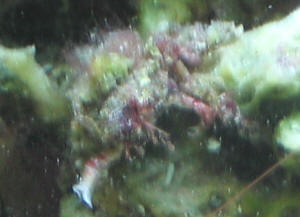 |
|
Possible ID please? snail and crab
11/13/10
Greetings to you and the crew,
<Richard>
Once again I find myself relying on your expertise to sort out
the miss-information I've gained through my research
attempts.
The snail I have come to believe could be a whelk of some sort...
but have also researched that since this shell does not display a
body two times longer then the spire, so it isn't.
<Mmm, give a read here: http://reefkeeping.com/issues/2005-11/rs/index.php
Unfortunately, I can not confirm where the little guy is from.
All the live rock is about a year or more old and was touted as a
combo of Fiji and Florida, with any frag/coral spending 8 to 10
weeks in isolation minimum... so I actually have no idea how long
it has been in there. I have him in a container with a small
piece of krill mash hopeful to observe it eat as I have read that
whelks can/do not eat algae - but apparently being captured has
put off his appetite. Could you possibly confirm what he is
please?
<Likely a Conch...
http://wetwebmedia.com/MolluscPIX/Gastropods/Prosobranch%20PIX/Conchs%20Strombids/ConchF1.htm>
On a side note - could it be the reason for the die-off on the
Monti?
<Mmm, not at all likely>
The crab was found on a piece of Haitian rock (still in
isolation) and I am thinking Mithrax...
<The genus? Nah>
'cept I can't find any as fuzzy or grainy as he is. Of
course, there isn't a wealth of 'identified' crab
pics out there either:) Another description leans towards
a Black-Finger Crab, but they generally do not show/have fuzz.
Presently he resides in a 3L Nano cube (no... not a typo) with
chelto (spelling?) left in at all times, Nori, veg and meat
flakes, and krill. I can't verify which he is eating. Again I
ask... Can you ID please?
<Not from this pic, no. Bob Fenner>
Richard
|
|
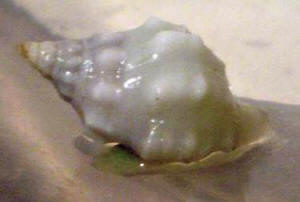 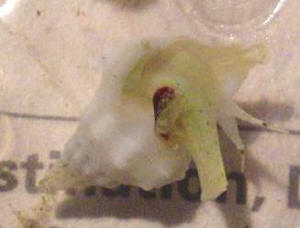 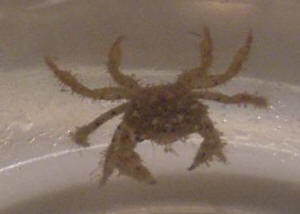
|
|
little crab inside my rock 9/28/10
Dear Sirs,
<Cedric>
I found this little look alike crab in one of my rocks (see the
pic enclosed).
<Umm, this is a Stomatopod... A Mantis shrimp>
Could you please indicate my what is it exactly? and what does it
feed on?
<Read here:
http://wetwebmedia.com/marine/inverts/arthropoda/stomatopods/mantisshrimp.htm
and the linked files above>
Thanks a lot
Regards
Cedric
<Watch your hands. Bob Fenner>
|
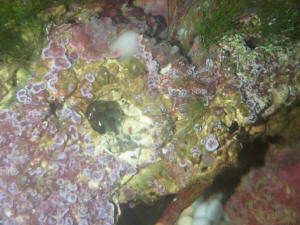 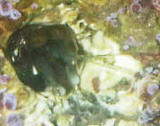 crop crop |
|
Mystery Crab - Friend or Foe? 9/6/2010
Since transitioning to saltwater almost a year ago, I've
spent countless hours reading articles and posts on WWM -- on
dial-up, no less! I have found it to be a valuable resource in my
saltwater tool chest.
<Ah good>
We have found/identified many critters that hitch-hiked on our
Caribbean live rock -- some good (tunicates, corals, sponges,
brittle stars, filter feeding cucumbers), some questionable
(urchins), and some bad (mantis shrimp). However,
I haven't had much luck identifying this rather attractive
little crab.
<Mmm, me neither... from the body shape, black tipped
principal claws I'd state it's a Xanthid
though...>
The shell is approximately ½' inch across,
'furry' legs (much like my Emerald crabs), 4 sets of
walking legs, peach/orange in color -- with some darker spots,
black tipped pinchers, nocturnal. No observations to report,
since it only appears in pitch darkness -- and immediately hides
when I try to spy on it with a flash light.
Attached pictures are of molt, not actual crab -- which I could
not photograph.
Hopefully, it will be sufficient to assist with
identification.
I have a mantis shrimp trap -- would this work for catching this
crab, should that be deemed necessary?
<Should work, and I would remove it...>
Thanks in advance.
Jennie
<Welcome. Bob Fenner>
|
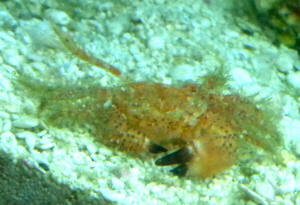 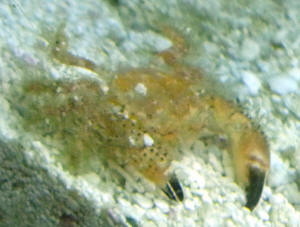 |
|
Crab ID -- 8/21/10
<Hello Krystal, Lynn here today.>
Couldn't find a photo of this critter in the crab ID section.
Any ideas?
<Heheeee - yes! Right now I'm wishing for the umpteenth
time that either I was the leading expert on crabs and knew all
six some-odd thousand species, including all the color
variations, on sight, or that there were only a handful of
species worldwide! If either were the case, you'd have your
answer in a heartbeat. Unfortunately, we're not so lucky. At
the moment, all I can really tell you with any certainty is that
what you have is indeed a true crab (Brachyuran) and that
it's a female. To take it any further, I'd need a bit
more information. For instance, do you know what part of the
world the crab came from? Did it hitchhike into your system on a
particular coral frag and if so, what type of coral? Finally,
what's the size of the crab? To be honest, most of the time,
we're lucky to get crab ID's narrowed to the family
level, much less to genus or specie. Just bear in mind that all
crabs are opportunistic and none are strict vegetarians. They
tend to be fairly innocuous when small, but can turn into real
problems as their appetite, and body, grows.>
Krystal Wessels
<Take care, Lynn Z>
Re: Crab ID - Possible Liomera sp. - 8/21/10
Hi Krystal,
I did some research after replying to your initial email and may
have gotten lucky. Your crab looks an awful lot like a Xanthid in
the genus Liomera. Take a look at the photos within the following
links:
http://calphotos.berkeley.edu/cgi/img_query?enlarge=4444+4444+1009+0802
Note the variations in color for Liomera tristis:
http://decapoda.free.fr/illustration.php?n=4&sp=412
I can't guarantee that's it's the exact species, but
it's close!
Take care,
Lynn Z
|
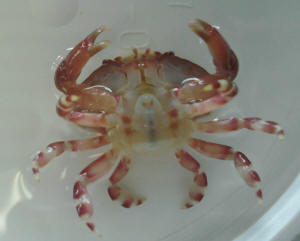 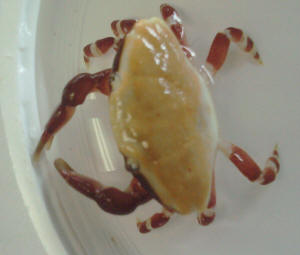 |
|
Follow-up Re: Crab ID - Possible Liomera sp. with a
Taste for Corals! 8/24/10
<Hello Krystal, Lynn here again.>
The Liomera definitely eats coral.
<Yikes!>
I gave her the option overnight of Mysis shrimp or Pocillopora,
and the Pocillopora is nearly half eaten with no missing Mysid
shrimps. Just an FYI :-)
<Yowza, thank you so much for the update! The next time I come
across this little crab in an ID query, I'll be sure to let
the person know that it has a taste for coral!>
Krystal Wessels
<Take care, Lynn Z>
|
|
Hitchhiker (Xeniid) crab ID 8/11/10
Hello there!
<Howdy>
I found this tiny hitchhiker crawling out from one of the stem of
my newly acquired Xenia colony!
It seems to be called Xenia crab but I could not find any further
information about it other than a few pictures from the web (and
on your wonderful site).
I was hoping you could help ID this crab for me?
Many thanks!
Jason
<Have seen this in the wild... believe it's a
Lissocarcinus species...
search this with the term Xenia commensal. Am putting in
LynnZ's in-folder as well. Bob Fenner>
Hitchhiker Crab ID: Porcellanid Xenia Crab --
8/11/10
Hello there!
<Hello Jason, Lynn here this afternoon!>
I found this tiny hitchhiker crawling out from one of the stem of
my newly acquired Xenia colony!
<It's a pretty little thing isn't it!>
It seems to be called Xenia crab
<Yep. There are photos of them all over the web, in various
BB's, and within WWM.>
..but I could not find any further information about it other
than a few pictures from the web (and on your wonderful site). I
was hoping you could help ID this crab for me?
<Hmmm, well I can tell you that it's not a true crab
(Brachyuran), but instead a false crab (Anomuran -- hermits, mole
crabs, squat lobsters, etc.). More specifically, it's a
Porcellanid (Porcelain crab) of some sort. If you take a good
close look at the photos, you can see that the last (almost
transparent -- very hard to discern) pair of legs is folded up
and held against the body. Of note is that although these legs
are mobile, they're not used for routine locomotion. Instead,
they're apparently used mainly for grooming. True crabs, by
comparison, use that last pair of legs for walking, burrowing, or
in some cases, swimming. Now, as to species, unfortunately, I
can't tell you with any certainty exactly what you have. I
can tell you that I found a photo of what appears to be a color
variant of the same crab in Poppe Images, and they ID it as
Porcellanella triloba: http://www.poppe-images.com/?t=17&photoid=909792
. It has the same dome-like carapace and serrations on the outer
edge, the same gracile, slightly curved claws, same claw arm
proportions, and the same general color pattern. What's
important to note is that the two also share a rather
flattened/straight area between the eyes. There are no apparent
projections of the carapace. The problem I have with this ID is
that every other individual that I've seen with the same
species name, has a distinct series of 3 projections between the
eyes. You can see them at this link (note species name): http://www.poppe-images.com/?t=17&photoid=942351
That's completely different than what we see in the first
photo. Am I saying they got the ID wrong? It occurred to me, yes,
but for all I know, the crab in the first photo could be a
juvenile; who knows? I'm not exactly the authority on crabs.
Given the choice, I'd go with their judgment over mine. Now,
as far as more information on these guys, I can tell you that
they're mostly nocturnal and are usually found in pairs so
bear that in mind if you decide on removal. As far as whether to
keep it/them, it's up to you. The general consensus seems to
be that they're better kept within a large Xenia colony than
a small one, mainly because any potential predation has less
overall impact and is less noticeable. Unfortunately, I can't
tell you one way or the other whether your crab will devastate
your colony or simply take a nip here and there but otherwise be
fairly innocuous. If it were me, I'd leave the little crab as
is, but keep a sharp eye on the Xenia. At the first sign of
trouble, I'd remove the crab and place it elsewhere. Please
see the following link for more photos of the crab similar to
yours (also see Porcellanella picta) and other examples of
Porcellanids on subsequent pages:
http://www.poppe-images.com/?t=11&family=porcellanidae&p=1
>
Many thanks!
<You're welcome!
Jason
<Take care, Lynn Z>
|
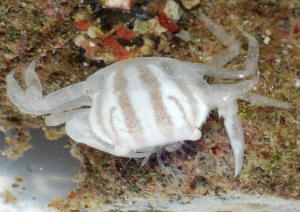 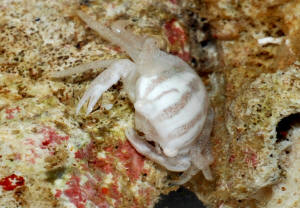 |
|
Help Identify: Two Florida Crabs --
4/4/10
Dear Wet Web Media
<Hello Dominick, Lynn here this evening.>
Hello once again I would like to express what a wonderful website
you have.
<Thank you!>
I am attaching two pictures of two different crabs, can you
please inform what species..
<Unfortunately no, I can't. There are an awful lot of crab
species out there and I can't see enough pertinent details in
either photo to be able to offer a species ID. When it comes to
identifying crabs, it's all in the details. These include
shape/texture/color of the overall carapace, whether it's
smooth or 'hairy', the number of spines/shape of the
carapace edge, eye placement/color, length of eye-stalks, how
many legs, the shape/length/color of legs and claws and whether
there are any 'teeth', spines, bumps, etc, on them, the
shape of the tips of the claws (are they pointed, blunt, or
spatulate), the depth of the body, etc, etc, and that's just
the basics. The list of criteria goes on and on! The best way to
ID these guys is to have them directly in front of you so that
you can pick out all the little details. Most of the time,
we're doing well to narrow things to the family level.
I'd recommend looking through Bob's crab article (see
link below), as well as any online sources offering photos of
crabs from Florida. You might want to perform a search using the
genus Mithraculus or Mithrax in Google's Image search engine
for help identifying the olive green crab:
http://images.google.com/imghp?hl=en&rlz=1T4GGIH_enUS263US264&tab=wi
Regarding the white crab, does it have dark claw tips? If so, it
could be some sort of Xanthid (family Xanthidae). Here's some
very basic info on the family:
http://en.wikipedia.org/wiki/Xanthidae
Here's page one of Bob's article:
http://www.wetwebmedia.com/marine/inverts/arthropoda/crabs/swcrabs.htm
>
... and if they are reef safe
<It depends on what you consider reef-safe. Crabs are
opportunistic omnivores that if hungry enough will eat anything
they can get their claws on, including snails, other crustaceans,
sleeping fishes, etc. There are no vegan crabs. I personally
don't trust them, keep them, or recommend them but if you do
want to keep these, I'd recommend offering them the
occasional meaty bits of marine origin.>
I live in Tampa and my son and I went snorkeling and found these
two crabs and put them in our reef tank.
<That's generally not a good idea. It may or may not be
legal, but even if it is, you risk introducing disease, unwanted
parasites, etc., into your system.>
I have never seen the white crab species before.
<I've only seen one all white crab from Florida:
Dissodactylus primitivus, a tiny 'pea' crab that lives on
Meoma ventricosa, aka the Red Heart Urchin. Here's a photo:
http://www.cryptosula.nl/photos/Dissodactylusprimitivusweb.jpg
Your crab appears to be mostly white but possibly has some sort
of pattern on the shell/carapace? If so, that could help you in
your efforts to find an ID.
Thank you.
<You're very welcome.>
Dominick Perrone Jr.
Culinary Arts Teacher
East Bay High School
"Condiments are like old friends - highly thought of, but
often taken for granted." Marilyn Kaytor
<Take care, LynnZ>
|
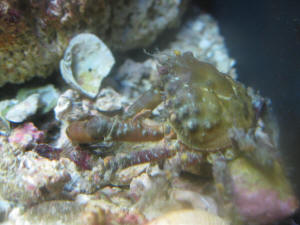 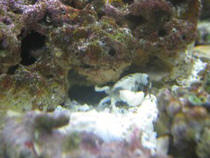 |
|
Acro Crab? Possible Trapeziid or Juvenile of
Undetermined Family -- 3/28/10
<Hi Mike, Lynn here today.>
Just found this little crab on a new shipment I just
received.
<Neat! What kind of shipment -- coral (Acropora, Pocillopora,
Stylophora, etc.?), rock, or something else? Where was the
shipment from? What's the size of the crab (carapace
width)?>
Hoping you can confirm whether of not it's an Acro crab?
<That's a tall order! Did it hitchhike in on an Acropora
colony? It could be a coral crab, or it could simply be a
juvenile of some other variety. It has the same large eyes,
roughly triangular carapace, and claw length/shape that you see
in many Trapeziid crabs (family Trapeziidae -- aka 'coral
crabs' or 'coral guard crabs'), but the color/pattern
of the carapace is atypical. That is, it doesn't fit with
what photos I've seen of Trapeziid crabs. The problem is that
there are an awful lot of crab species out there, not all of
which are available as photos on the web or in my research books.
What you have may be a coral crab that in its juvenile phase has
a completely different, more cryptic coloration, than its adult
counterpart. This is not at all unusual in crabs, or other
animals for that matter. Unfortunately, I haven't been able
to find any photos of juvenile Trapeziid crabs for comparison.
Again, there's the distinct possibility that this little crab
could simply be a juvenile from any number of other families.
Juvenile crabs typically have the same large eyes that you see in
Trapeziids. The bottom line here is that unfortunately, all I can
offer are a whole lot of maybes and no concrete answers. Time and
behavior will tell with this little fellow. I can tell you one
thing though. Trapeziids are generally found in the Pacific,
either the Indo-West or tropical Eastern regions. If this little
crab came in on a shipment from say Florida or the Caribbean,
chances are it's not a Trapeziid. Please see the following
link for an example of a juvenile Callinectes sapidus, aka
'blue crab' (see last photo). This is definitely not what
you have (and not a variety of coral crab), but you can see the
similarities:
http://www.serc.si.edu/education/resources/bluecrab/lifecycle.aspx
Here are some examples of coral crabs, along with more info (see
bottom of page):
http://www.chucksaddiction.com/hitchcrabs.html
More info at WWM:
http://www.wetwebmedia.com/Arthropoda/CrustaceanPIX/SWCrabs/Crab%20IDs/SWCrabs3.htm
>
And good/bad?
<Time will tell. This could be a relatively harmless coral
crab, or something else entirely. Since I can't confirm
either way, I'll offer the standard crab warning. That is,
crabs are omnivorous opportunists and scavengers that, if hungry
enough, can and will eat pretty much anything they can grab with
their claws. You have the choice of keeping, observing, and
removing if/when the crab becomes a problem or playing it safe
and putting it elsewhere until you have a better idea what it is
and how much risk it poses to other livestock. Either way, do be
sure to keep it well-fed with meaty scraps of marine origin
(shrimp, clam, squid, fish, etc.) or perhaps sinking
pellets.>
Attached a pic for ID.
<Thanks, he/she certainly appears to be an itty-bitty
thing!>
Thanks!!
<You're welcome!>
Mike
<Take care, LynnZ>
Re: Acro Crab? Possible Trapeziid or Juvenile of
Undetermined Family -- 3/28/10
Lynn,
<Hi Mike>
Thank you for the response.
<You're very welcome.>
He was attached to a "purple monster Acro" from either
the Solomon Islands or Fiji, my supplier only specified vaguely
where all our corals came from, one or the other.
<Thanks, that helps. I just wish that it was enough to be able
to offer you a positive ID! As it stands right now, I'm not
sure what type of crab this is. As was evident in the photo of
the blue crab (see link in previous response), appearance can
change significantly from juvenile to adult. We should know more
as this little fellow matures. Honestly, it could be one of many
different genera (not just in the family Trapeziidae) that are
associated with Acroporids. It could also be an accidental
hitchhiker; that is, not a coral crab at all. Perhaps it was
ousted from its normal habitat during collection and simply took
refuge within the coral's branches.>
I've attached a not so macro pic for a naked eye view as
well. He is tiny, maybe 3-4 mm.
<Yep, that is one small crab!>
Thanks again!
<It was a pleasure! I'm just sorry that I couldn't
give you a more definitive answer.>
Mike
<Take care, LynnZ>
|
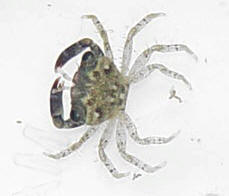 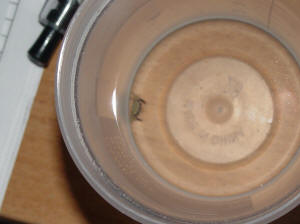 |
|
Crab ID, Please: Likely Decorator Crab --
3/6/10
Good evening,
<Good evening Laura, Lynn here tonight.>
Thanks once again for providing such a wonderful resource.
<It's always a pleasure.>
I looked through your crab ID photos, but I didn't see anyone
who looks like the critter that I saw tonight for the first time.
We haven't purchased any live rock (or anything else) for
months, so I was very surprised to see someone new.
<It happens, especially with little crabs like this
one.>
The picture is a bit blurry, but if you have any ideas about who
this is, I would love to hear them.
<Judging by the amount of 'stuff' it appears to be
carrying around on its body, it's most likely some sort of
decorator crab, family Majidae. These crabs collect bits and
pieces of algae, detritus, sponges, hydroids, corals, etc., and
attach them to their carapace and legs in order to blend in with
the environment and avoid predation.>
Please let us know if he looks untrustworthy.
<All crabs look untrustworthy to me! They're opportunistic
omnivores that scavenge and eat pretty much anything they can
grab and hang on to. This little fellow appears to be fairly
small so his diet most likely consists of bits of algae,
detritus, and small invertebrates such as worms, feather dusters,
etc., that it picks from the rocks thanks to a pair of slender
claws. When/if this individual grows larger, it may add snails,
hermits and other crustaceans to the menu. Unfortunately,
there's no way I can positively ID the crab to species level,
or specify its maximum potential size. If you do decide to leave
the crab in place, be sure to offer it the occasional meal of
pellet food or meaty bits (of marine origin) such as shrimp,
fish, clam, etc., to help deter unwanted predation. For more
information, please see the following links:
http://www.wetwebmedia.com/DecorCrabsF.htm
http://www.wetwebmedia.com/Arthropoda/CrustaceanPIX/SWCrabs/Crab%20IDs/SWCrabs2.htm
>
Thanks again!
<You're very welcome!>
Laura
<Take care, LynnZ>
|
 |
|
|

